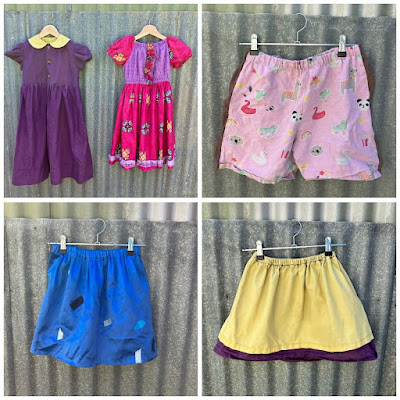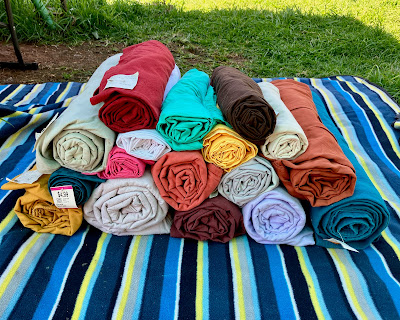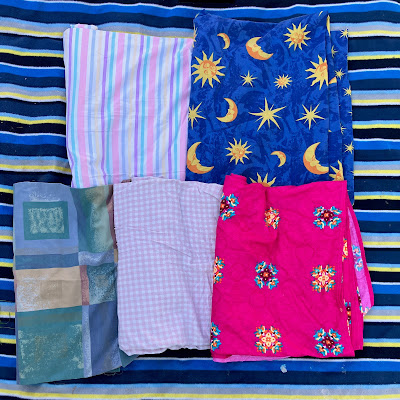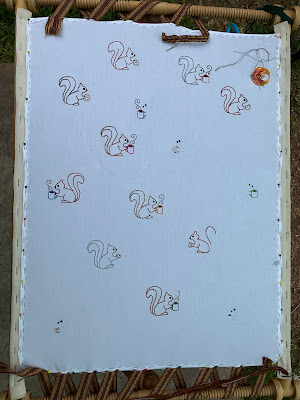The Dilemma
When it comes to my clothes, I'm a remarkably lazy snob.
I want things that fit well. (This isn't an unreasonable thing to want, I feel.) I want comfortable fabrics that breathe, and don't end up smelling like a billy goat slept on them. (I swear, since starting T, I strip my shirts more often than I ever had to strip the cloth nappies.)
I want colours - black and white and grey don't count - that don't make me look dead. (When did all the t-shirts in the men's section become navy and olive?) And I want them to last longer than six months before they start a part-time internship in the mending box.
 |
| The pile doth wax and the pile doth wane, but there's always a bloody pile. |
This short list is surprisingly difficult to achieve, off the rack. Anything that fits my shoulders won't fit my chest, and vice versa. The armscye is usually either comically large, or too small to fit my biceps. And pants? Let's just not go there. (Belts help. Kind of.)
I really dislike how polyester and other synthetics breathe (they don't), so I avoid them whenever I can. It's getting much harder to find clothes made of 100% natural fibres, whether new or second-hand.
Colours I have slightly more luck with - or I would, if the first two things didn't get in the way. Longevity is always an utter crapshoot. (Though I've found that wovens last longer than t-shirts.)
The Solution
Luckily, I know how to sew. I used to do it for a living. (Not clothes, mind - baby carriers. More structural, less technically complex.) My possess all the basic tools, a few of the extras, and a reasonable set of skills.
 |
| I've been making clothes for the kids for years - they care a lot less about style and fit. And skirts are easy. |
So I'm taking a two-pronged approach to this dilemma. I'm practicing making things I actually like and will wear, and religiously patching my current wardrobe while I make replacements.
Making clothes, naturally, requires material. So instead of going to the op shop for clothes, I'm going for fabric. (I stopped buying new years ago, except for underwear, shoes, and the occasional really high quality item from places that at least pretend to pay their garment workers.) But my favourite deal-hunting section isn't sewing/craft - it's the linens.
Wait, what? Why?
Thrift store fabrics usually can't tell you what they're made from. (The staff get narky when you try to burn test the goods, sadly.) Plus there's just not that much of it. Bedding, tablecloths etc are donated far more frequently, and often still have their tags on them.
Now, you do have check for wear. Some donations look brand new, some have had a long life already. Check for pilling or thinner areas, especially in the middle of bedsheets (fitted ones are worse for this than flats). It's easier if you can hold things up to the light. Usually things in worse condition will be priced lower, but not always.
Why not buy clothes six sizes too large and chop them up to make new stuff?
I mean, you can. It's certainly a common choice, what with all the "thrift upcycle/refashion" videos and blogs and such out there dedicated to it. I personally don't, for the following reasons.
Care for people: I take the permaculture ethics seriously.
Have you ever really looked at the racks in an op shop? Piles of sizes S-L, much less outside of that. The bigger your meatsuit, the harder it is to find things that have a hope of fitting. Too bad if you hate stripes, or the fabric is itchy - if there's only two things in your size, then that's the choice you have. It sucks. (I am in no way body shaming here. Bodies do a lot of hard work for the people who live in them, and no one gets to judge anyone else's.)
I'm both outside the common sizes, and a weird enough shape to have trouble besides. And I've been broke enough that op shop clothes were a necessity, not a choice. I know what it's like to have to take what I could get as long as it fit "enough".
To me it is deeply unethical to take the few decent garments that are available for plus sized people, chop them up, and make something for me to wear out of them, when I can just as easily start with a sheet or a table cloth and achieve a similar result.
Efficient energy planning: I have limited time and brainpower available, and sometimes my executive dysfunction is bad. Like, "I'm eating peanut butter out of the jar for dinner because my brain has stopped" levels of bad.
Cutting up a garment, taking off buttons, and so on, adds several extra steps to a sewing project. Sometimes that's fine - in those situations, I have plenty of old clothes in the stash. More often, though, those extra steps completely derail me.
So I find it easier to start a project with what is essentially yardage. Even when I have to cut around stains, rips, or worn spots, it uses less cognitive capacity.
I also prefer rectangularly cut garments, and zero waste patterns that have you draw directly onto the fabric. These work better on something that started out life as a rectangle.
Use biological resources: Natural fibres are renewable. Mined ones are not. Where I can, I use the former. That's not to say I never use things with synthetic content - it's technically possible, but in practice hard as hell.
Produce no waste: I've still got a sizeable stash of acrylic knitting yarns, plus other bits and bobs, hanging around from before I made this commitment. Throwing them out or donating them (ie making them someone else's problem) won't actually fix things; I simply use them in appropriate projects, and when I replace them, I do so with things that fit my current ethical stance and needs.
But sheets are all plain white and boring!
I can see why you might think that. TV has done a lot of false advertising on that point. It is false. Trust me.
 |
| Ignore the movies. Real sheets come in just about every colour you can think of. |
But, I know not everyone likes plain colours. What if you're madly in love with prints, or shirts with witty slogans on them? Well, besides the growing number of fancy sheets out there, might I interest you in the doona covers?
 |
| The top right and bottom left are ex-doona covers. The rest are sheets. |
Or the fine art of embroidery?
 |
| I shall have the most glorious shirt sleeves when I finish embroidering them. |
Or fabric painting?
 |
| This is technically a mend, but I totally plan on doing similar to brand new things I make. |
Or the many different styles of natural dyeing?
 |
| Soursobs from the local park, gently turning into dye liquor for some dyeing experiments. |
Or, if you've got lots of smaller or oddly shaped pieces of fabric hanging around, maybe some patchwork (all YouTube links)? It's not just coats and dressing gowns, either - you can patchwork jeans, trousers, dresses, shirts and more.
The point here is that fabric (and buttons, zips, thread, etc) doesn't have to be a thing you buy brand new. With time, patience, and a bit of luck, you can find everything you need to create great things second hand.
(Maybe I'll write a future post breaking down the costs of some of the things I've made...)
No comments:
Post a Comment